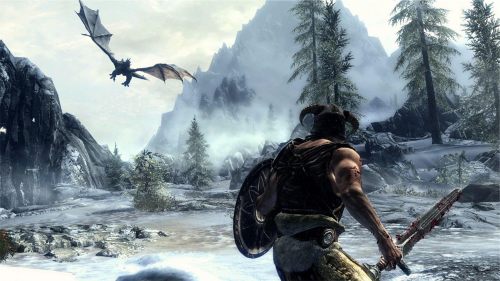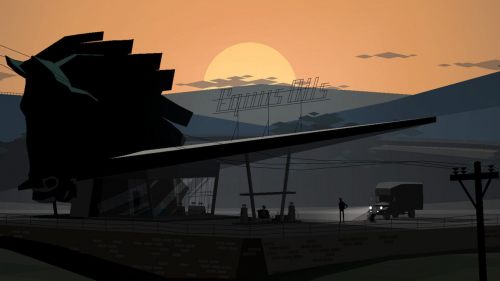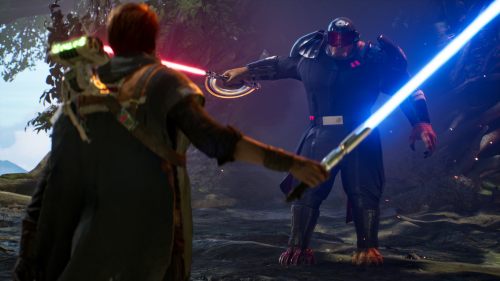WOLFENSTEIN II: THE NEW COLOSSUS Game Review: Violence Against Violence
Wolfenstein: The New Order was something of a miracle. A fresh entry in a stale franchise, it not only delivered outstanding first-person shooting, but told a hilarious, intelligent, and moving alternate-history tale that straddled that perilous line between high and low art. Its sequel, Wolfenstein II: The New Colossus, has big shoes to fill, and in setting its action in Nazi-occupied America (the title refers to the poem at the base of the Statue of Liberty), big ambitions. I wouldn’t expect or want anything different from developer MachineGames after The New Order.
So story-driven is The New Colossus that it opens with a recap of the previous game, introducing the player to its delightful, diverse cast of characters just in time to pick up right where it left off. If you’re not up with the play: in this alternate history, the Nazis won World War II, spreading across the globe, nuking New York, and developing bizarre, twisted technology like flamethrowing robot dogs, moon lasers, and mech suits. Protagonist William Joseph Blazkowicz barely survived the nuclear explosion at the end of the first game, starting The New Colossus feeling sorry for himself in a wheelchair. He doesn’t stay in that wheelchair long, though, soon coming into possession of a high-tech suit of mechanised armour that allows him to run, jump, and crawl his way into occupied America, expand his team of revolutionaries, and shoot the motherfucking shit out of some goddamned Nazis.
Wolfenstein II doesn’t pull punches when it comes to depicting Nazi-occupied America. In this alternate history, white America essentially rolled over for their new oppressors - handing the South to the KKK as surrogate rulers, reinstituting slavery, and happily complying with all the hallmarks of Nazi rule, because hey, it doesn’t affect them. Any resistance comes from minorities - like the one led by the terrific new character Grace - or international groups of misfits, like Blazkowicz’s Kreisau Circle. Hitler’s in this too, and the game really goes to town on him - far from his Wolfenstein 3D depiction as a mech-suit-wearing uber-warrior, he’s old, decrepit, and living a pathetic Howard Hughes lifestyle of isolation, peeing in a bucket and having coughing/vomiting fits in his plush office on Venus.
Oh, yeah - Wolfenstein II’s sci-fi elements are absolutely fucking bonkers, from the Nazis casually having conquered the solar system to the development of advanced robot limbs, anti-gravity vehicles, and borderline supernatural surgical procedures. Jaw-droppingly audacious material pervades the game, both on a visual and narrative level; every time it seems to have peaked, there’s still more in the tank. This is a game whose story contains multiple nuclear bombs; that savages white America as much as it does Nazis; that has a significant portion set in Roswell and actually manages to go weirder than “it was aliens.”
Crucially, Wolfenstein II, like its predecessor, treats all this wild shit - and the characters within it - completely seriously. Without a well-written, well-performed dramatis personae, it’d be pure exploitation, but developer MachineGames dodges that hail of bullets once again. The Kreisau Circle’s rebels are easy to love, whether in cutscenes - including a party scene that had me grinning ear-to-ear - or the many between-mission conversational sequences. One sequence even has rebel leader Grace breastfeeding her baby during a key cutscene - a delicate, casually human touch to a badass character the likes of which I’ve never seen in a video game. These are people with real lived experiences and real lives; if anything, I wanted more of their personal stories and less quote-unquote “plot.”
BJ Blazkowicz himself, too, gets some welcome development. Through cutscenes and interactive sequences, we jump back to BJ's childhood for surprisingly moving sequences of backstory. BJ’s dad is a borderline caricature of Southern racism and toxic masculinity, rescued from pastiche by Glenn Morshower’s committed performance. The game forces players to live Blazkowicz’s childhood trauma, making his adult voiceovers feel all the more poetic, his own attempts to build a family more laden with meaning. The hatred in BJ’s all-American past is echoed in his Nazi-occupied present, with the latter inextricably linked to and caused by the former. It’s incredibly sad and every bit as astonishing as the more ridiculous material, for wholly different reasons.
The New Colossus’ gameplay doesn’t quite make the dramatic leaps and bounds that its story does. The basic gameplay - shoot your way through armies of Nazis, or sneak around killing them stealthily - retains its thunderous, tactile feel, but its balance has shifted somewhat. Stealth is less forgiving in The New Colossus than in its predecessor, with seemingly the entire ultra-aggressive Nazi army being sent after Blazkowicz at the slightest provocation. That’s annoying for stealthy players, but it makes sense: he’s the world’s most wanted terrorist, and the game is even more explicitly about killing than its predecessor. The New Order wanted you to complete your mission; The New Colossus wants you to kill Nazis.
Oh, the Nazis you’ll kill, too. Each of Wolfenstein II’s surprisingly old-school, maze-like levels crawls with the motherfuckers, all eager to get gunned down (or axed in the face) by BJ Blazkowicz, aka Terror-Billy. Every one of the game’s weapons feels weighty and powerful, with a strong sense of physicality bolstered by a best-in-class lean function. Killing Nazis with the heavy weapons, especially - melting them with a laser, incinerating them with a diesel launcher, pulping them into hamburger meat with what I can only describe as a shotgun-shell Gatling gun - is an utter joy. It’s the kind of hyper-glorified violence that would normally give me pause, but frankly, in 2017, gunning down video-game Nazis is, as the kids say, “cathartic as fuck.”
While killing Nazis will never get old, Wolfenstein II still stretches itself a little too far - and predictably, it’s all in the name of extending playtime and increasing replay value. Those shallow measures of game value, all the rage to major studios right now, are surely to blame for the inclusion of the game’s optional assassination missions, which see BJ re-infiltrating remixed versions of the game’s levels to take out specific Nazi commanders. Though these missions technically offer additional gameplay challenges, and enable players to toy around with the various gadgets BJ acquires through the game, they’re not new content and don’t contain new mechanics. In a game as story-focused as this one, these borderline procedural missions feel oh-so-transparently tacked on.
But The New Colossus’ content repetition almost doesn’t matter, because its best bits don't involve shooting at all. By far the highlights of the game are the sequences where BJ is allowed to simply explore the game’s more densely-filled environments, talk to other characters in the sprawling between-mission submarine hub, and perform tasks that don’t involve pulling triggers. That’s where the deepest story material gets deployed, in the form of environmental design and newspaper clippings. It’s where the game’s support cast comes into their own, full of life and humour and longing. And it’s where the most interesting design choices get made, putting BJ and his game engine in situations hilariously alien to them. There’s a level in there directly inspired by Gone Home. In a Wolfenstein game. Let that sink in a little.
Amidst all its masterful inversion of cliches, Wolfenstein II: The New Colossus has something blunt to say. Its ultraviolent Nazi slaughter is paired with a story that deals explicitly with cycles of violence and hatred, coming to a firm conclusion that sometimes, turning the other cheek isn’t enough. I’ve never seen a shooter this morally righteous about its use of violence. Usually games either ignore the issue or revel in their amorality, but Wolfenstein II uses its violence to make a statement about the cycle of violence and the ways in which people channel their trauma. BJ Blazkowicz channels his trauma into killing Nazis, and MachineGames clearly reckons that’s justifiable. Frankly, in the context of the story, so do I.
The game’s abrupt ending suggests material was cut during production or saved for another sequel, but just as surprising as its timing is its content. It’s a straight-up Great Dictator riff, in which the resistance characters, speaking via in-universe TV broadcast, exhort the player to fight Nazis wherever they may find them. Sometimes, says Wolfenstein II, hatred and violence gets so extreme that it can only be ended with more violence. That goes counter to most conventional views of conflict resolution, and it’s a chunky flag to fly in 2017. Many games present violence as the only option, but few actually develop that idea consciously. Wolfenstein II does, and for that, I’m grateful.
I’m glad this kind of crafted single-player game can still get made, and I truly hope MachineGames gets to finish its story. Pray it doesn’t go under like so many other single-player-focused studios these days.



